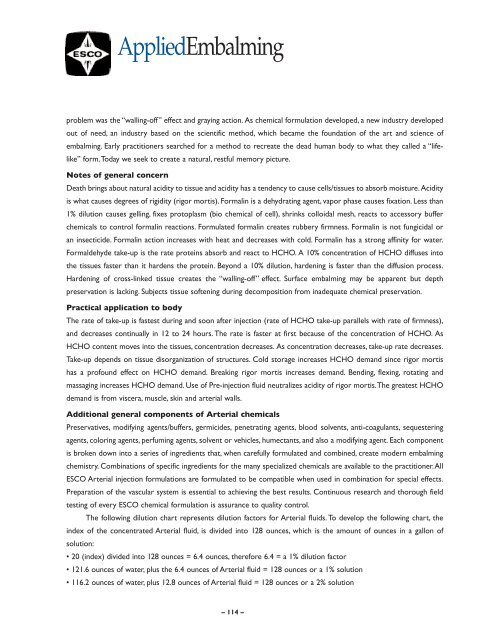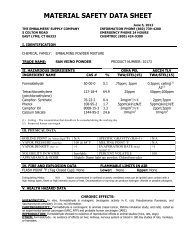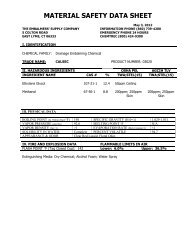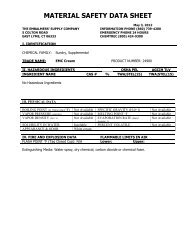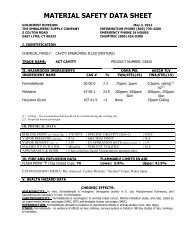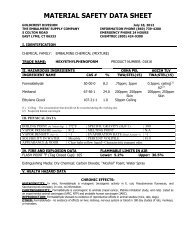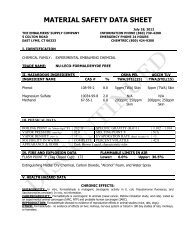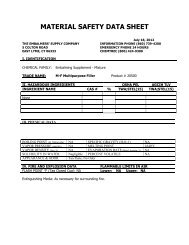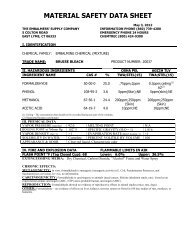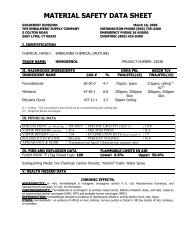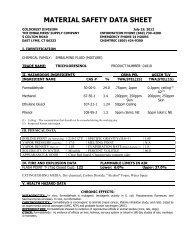Executive Offices - Embalming Supply Company
Executive Offices - Embalming Supply Company
Executive Offices - Embalming Supply Company
You also want an ePaper? Increase the reach of your titles
YUMPU automatically turns print PDFs into web optimized ePapers that Google loves.
Applied<strong>Embalming</strong><br />
problem was the “walling-off” effect and graying action. As chemical formulation developed, a new industry developed<br />
out of need, an industry based on the scientific method, which became the foundation of the art and science of<br />
embalming. Early practitioners searched for a method to recreate the dead human body to what they called a “lifelike”<br />
form. Today we seek to create a natural, restful memory picture.<br />
notes of general concern<br />
Death brings about natural acidity to tissue and acidity has a tendency to cause cells/tissues to absorb moisture. Acidity<br />
is what causes degrees of rigidity (rigor mortis). Formalin is a dehydrating agent, vapor phase causes fixation. Less than<br />
1% dilution causes gelling, fixes protoplasm (bio chemical of cell), shrinks colloidal mesh, reacts to accessory buffer<br />
chemicals to control formalin reactions. Formulated formalin creates rubbery firmness. Formalin is not fungicidal or<br />
an insecticide. Formalin action increases with heat and decreases with cold. Formalin has a strong affinity for water.<br />
Formaldehyde take-up is the rate proteins absorb and react to HCHO. A 10% concentration of HCHO diffuses into<br />
the tissues faster than it hardens the protein. Beyond a 10% dilution, hardening is faster than the diffusion process.<br />
Hardening of cross-linked tissue creates the “walling-off” effect. Surface embalming may be apparent but depth<br />
preservation is lacking. Subjects tissue softening during decomposition from inadequate chemical preservation.<br />
Practical application to body<br />
The rate of take-up is fastest during and soon after injection (rate of HCHO take-up parallels with rate of firmness),<br />
and decreases continually in 12 to 24 hours. The rate is faster at first because of the concentration of HCHO. As<br />
HCHO content moves into the tissues, concentration decreases. As concentration decreases, take-up rate decreases.<br />
Take-up depends on tissue disorganization of structures. Cold storage increases HCHO demand since rigor mortis<br />
has a profound effect on HCHO demand. Breaking rigor mortis increases demand. Bending, flexing, rotating and<br />
massaging increases HCHO demand. Use of Pre-injection fluid neutralizes acidity of rigor mortis. The greatest HCHO<br />
demand is from viscera, muscle, skin and arterial walls.<br />
additional general components of arterial chemicals<br />
Preservatives, modifying agents/buffers, germicides, penetrating agents, blood solvents, anti-coagulants, sequestering<br />
agents, coloring agents, perfuming agents, solvent or vehicles, humectants, and also a modifying agent. Each component<br />
is broken down into a series of ingredients that, when carefully formulated and combined, create modern embalming<br />
chemistry. Combinations of specific ingredients for the many specialized chemicals are available to the practitioner. All<br />
ESCO Arterial injection formulations are formulated to be compatible when used in combination for special effects.<br />
Preparation of the vascular system is essential to achieving the best results. Continuous research and thorough field<br />
testing of every ESCO chemical formulation is assurance to quality control.<br />
The following dilution chart represents dilution factors for Arterial fluids. To develop the following chart, the<br />
index of the concentrated Arterial fluid, is divided into 128 ounces, which is the amount of ounces in a gallon of<br />
solution:<br />
• 20 (index) divided into 128 ounces = 6.4 ounces, therefore 6.4 = a 1% dilution factor<br />
• 121.6 ounces of water, plus the 6.4 ounces of Arterial fluid = 128 ounces or a 1% solution<br />
• 116.2 ounces of water, plus 12.8 ounces of Arterial fluid = 128 ounces or a 2% solution<br />
– 114 –


